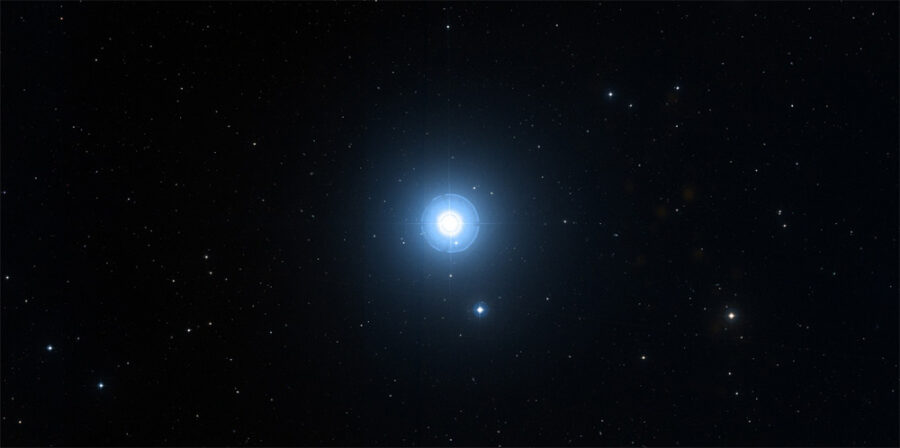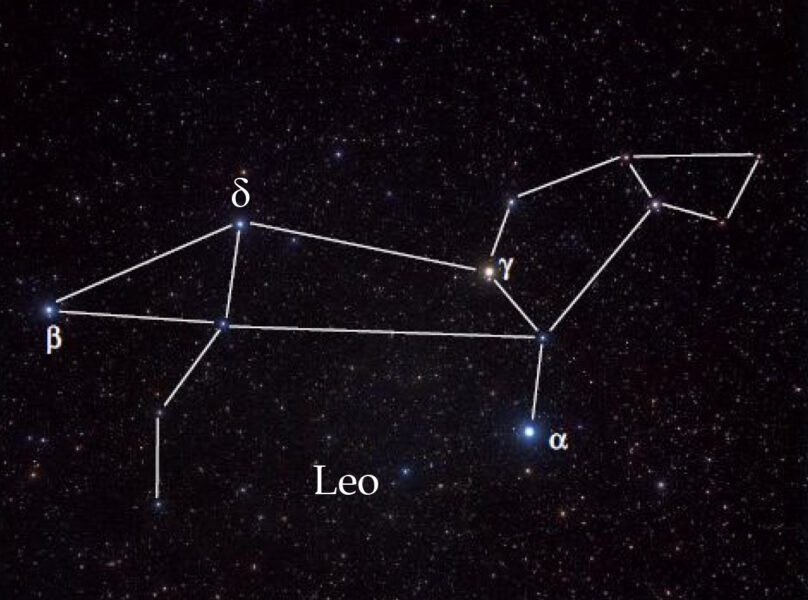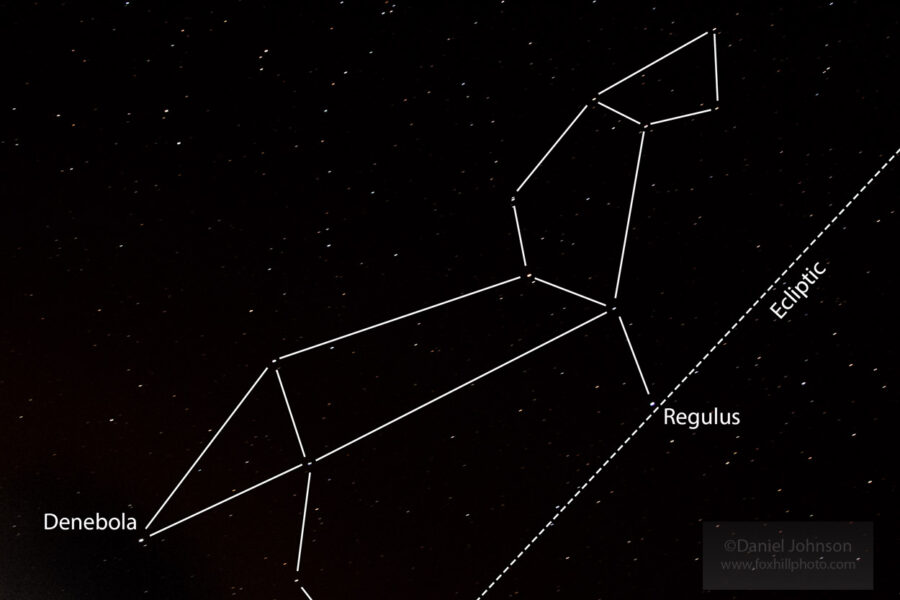Meet Denebola, the tail of Leo, the Lion. This young star is a fast rotater but otherwise not that different from our Sun.
The Vitals
| Official name | Denebola |
| Other designations | Beta Leonis, HR 4534, HIP 57632, HD 102647 |
| Nicknames | - |
| Apparent magnitude | 2.13 |
| Distance | 35.9 light-years |
| Spectral type | A3 |
| Color | White |
| Mass | 2.0 M☉ |
| Radius | 1.75 R☉ |
| Constellation | Leo |
| Right ascension | 11h 49m 03s |
| Declination | +14° 34' 19" |
| Multiple system? | No |
| Variable star? | Yes (Type: Delta Scuti) |
| Exoplanet status | None known but has a faint debris disk |
| Probable fate | White dwarf |
Physical Characteristics

Digitized Sky Survey (STScI / NASA); colored & healpixed by CDS
The colorful phrase “catch a tiger by the tail” means to contend with something difficult or challenging. While there are no tigers in the 88 officially recognized constellations, there is one very famous lion — and luckily for us, catching him by the tail is super easy to do.
The tail of Leo, the Lion, is marked by Denebola, a 2nd-magnitude main-sequence star that isn’t all that different from the Sun. To gain a better mental image of the star, a few simple comparisons are helpful. First, imagine the Sun with its radius increased by about three-fourths. That might seem like a lot, but in the case of Denebola, it’s only about an additional 483,000 km (300,000 miles); in contrast, Mercury’s orbit averages about 58 million km from the Sun. So while Denebola is larger than the Sun, it’s not an unusually large star overall.
Now take your enlarged Sun and start spinning it — really fast. The Sun is in no hurry in this respect and completes a single revolution in about 25 Earth days, but Denebola cranks out a single revolution in less than an Earth day. The star’s equator whips around at 125 km per second (280,000 mph)! This puts Denebola in a class with stars like Vega, Altair, and Regulus, in which rapid spin causes the equator to bulge dramatically, distorting the star’s normal spherical shape.
Next we need to take our enlarged, distorted Sun and increase its luminosity. If Earth orbited Denebola, you’d need more than sunglasses to protect your eyes, as the star shines about 15 times brighter than the Sun.
Denebola also appears to be young, around 100 million years old compared to the Sun’s 5 billion years. Indeed, infrared studies of Denebola indicate the presence of a faint debris disk, which could contain growing planetesimals as well as dust lanes. While planets could be forming in the disk, there haven’t been any conclusive detections.
And there you have it: a bright, white, hot, main sequence star just beginning the prime of its life.
Origin / Mythology
Constellations can sometimes be interpreted in various ways; for instance, illustrated renderings of Ursa Major sometimes show the bear facing left, other show him turned away to the right. Is Alkaid the bear’s nose or his tail?

Akira Fujii
Leo doesn’t suffer from this issue. Both the Greek and the Arabic star traditions hold the constellation to take the shape of a lion; furthermore, the name Denebola comes from the Arabic phrase Danab Al Asad, which means “tail of the lion.” So it’s obvious that Leo faces the right, and Denebola marks the tip of the lion’s tail.
Ancient Chinese stargazers had a different view of Denebola, though. Instead of a lion, they included Denebola as the first of a grouping of five stars called the Seat of Five Emperors. In traditional Navajo stories of the American southwest, Denebola is part of a huge constellation representing a bird carrying a feather; Denebola marks the tip of the feather.
How to See Denebola
On late spring evenings in the Northern Hemisphere, turn to the south and look up to enjoy Leo, one of the season’s clearest constellations. Sailing high in the sky and just south of the Big Dipper (which is nearly at the zenith on spring evenings), Leo takes over the southern sky after Taurus, Orion, Canis Major, and Gemini dominated it all winter. Leo (especially Regulus, its alpha star) is also very close to the ecliptic, so expect to find the Moon wandering through the constellation at some point each month. Of the main bright stars that make up the basic outline of the lion, Denebola is the farthest to the left, forming a neat little triangle with nearby bright stars Arcturus and Spica.

Daniel Johnson
Deep-sky fans might want to take a closer look in Denebola’s neighborhood, as the Leo Triplet of galaxies, consisting of M65, M66, and NGC 3628, is nearby. The triplet contains three beautiful galaxies packed in a tight space.
Stargazing on spring evenings can be very pleasant as we can finally enjoy the warm night air after months of chill, so why not try it for yourself tonight? Head outside after dusk, and you just might catch a Lion by the tail.
Daniel Johnson is a Wisconsin-based freelance writer and professional photographer and the co-author of over a dozen books. He’s a longtime amateur astronomer and fortunate enough to live in a rural region with excellent seeing conditions. You can view some of Dan’s photography (he does a lot of animals!) at foxhillphoto.com.
 2
2









Comments
Rod
May 31, 2022 at 9:13 am
"The star’s equator whips around at 125 km per second (280,000 mph)!"
Yes, very fast rotation. The Sun at its equator spins close to 2 km/s compared to 125 km/s. I am glad for that 🙂
You must be logged in to post a comment.
Anthony Barreiro
June 1, 2022 at 4:40 pm
I prefer to see Denebola as the base of the lion's tail, with a string of faint stars winding north and east to the big open cluster Melotte 111, "Cauda Leonis," the tuft of fur at the end of the lion's tail (rather than Queen Berenices' hair). If Denebola is the whole tail, then the lion's tail was cropped off at the base, a sad fate.
Indeed that's the story Ian Ridpath tells for the creation of the Coma Berenices constellation. http://www.ianridpath.com/startales/comaberenices.html Queen Berenices (a real historical person, third century BCE) cut off her golden tresses as a sacrifice to the gods to celebrate her husband King Ptolemy III's victory in war. The queen's hair was stolen from the temple, angering the king and queen. The quick-thinking court astronomer Conon of Samos pointed to the tuft of Leo's tail and said it was Berenices' hair elevated to the heavens by Zeus. The royal couple happily accepted this implausible explanation. Cutting off a lion's tail to flatter a queen. Somebody should call the SPCA.
You must be logged in to post a comment.
You must be logged in to post a comment.